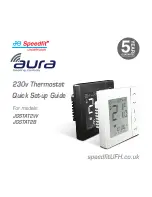
T-901/T-903/T-905 Instruction Bulletin 3
mechanism changes location of the set point screw
with respect to the control rod, thus changing the set
point.
Range of Remote Readjustment
The range of remote readjustment is the number of
degrees the set point can be changed as master
pressure changes from zero to maximum. The
readjusting bellows moves a fixed amount for each
psi change in master pressure. Since the movement
is transmitted through the readjustment spring, Fig. 3,
to the readjusting mechanism, the amount of channel
movement depends upon where the pin rests on the
spring. The pin, also shown in Fig. 3, is rigidly
attached to the post. Turning the dial and post
results in a varying channel movement from 0 to
100 percent of bellows movement. The readjusting
dial is calibrated in degrees F of remote readjustment
for a full change in master pressure. The possible
minimum and maximum ranges vary with the
maximum master pressure available. The “Range of
Remote Readjustment” for various master pressure
ranges is shown in Table II.
Stops for Readjustment Mechanism
Sometimes it is necessary to readjust the submaster
thermostat over only a portion of the master pressure
range. Special stops are available to make this
possible. These stops, Fig. 4, may be arranged to
limit readjustment at the lower end only, or in both
directions, as required.
Adjustment
Setting Range of Remote Readjustment
The readjusting dial, Fig. 2, is used to adjust the
range of remote readjustment. It is calibrated in
F degrees for a full change of master pressure.
The range of remote readjustment is obtained from
control system design information, for example:
MASTER PRESSURE
TEMPERATURE
0 psi
140
°
F
15 psi
65
°
F
The range of remote readjustment is:
140 - 65 = 75 F
°
.
Set the readjusting dial at 75 degrees.
Checking the Range of Remote Readjustment
1.
Set master pressure to either its extreme
maximum or extreme minimum value.
2.
Turn the lower adjusting screw until an
intermediate control line pressure is obtained,
e.g. 10 psi. Make a written note of the lower dial
setting at this pressure.
Fig. 4: T-901 Series Submaster Thermostat
Showing Adjustable Stops






















